maintenance OLDSMOBILE SILHOUETTE 1995 Owners Manual
[x] Cancel search | Manufacturer: OLDSMOBILE, Model Year: 1995, Model line: SILHOUETTE, Model: OLDSMOBILE SILHOUETTE 1995Pages: 390, PDF Size: 20.27 MB
Page 5 of 390
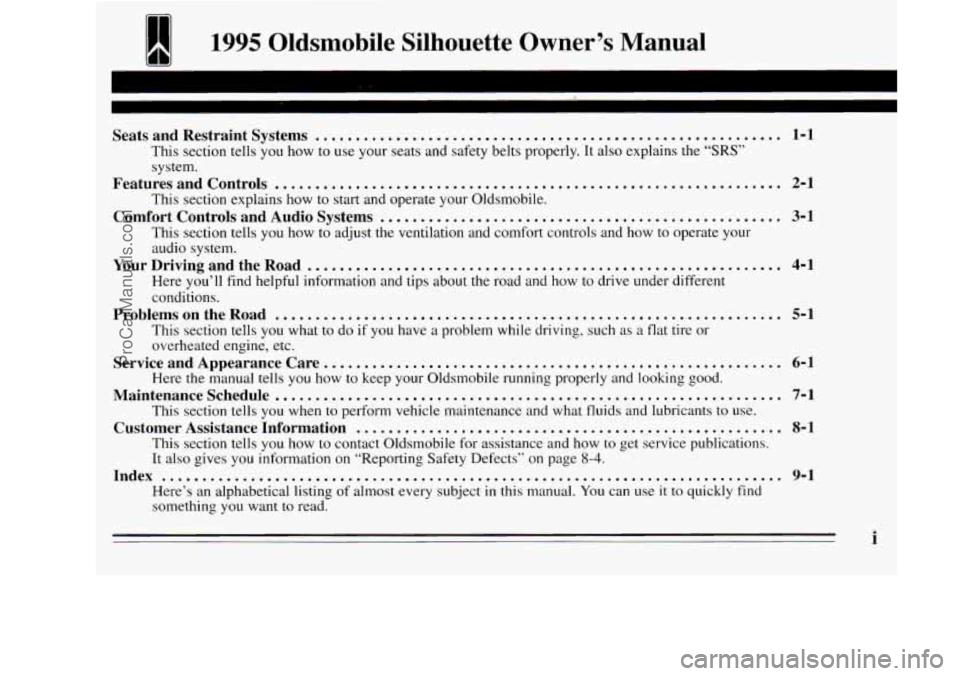
1995 Oldsrnobile Silhouette Owner’s Manual
Seats and Restraint Systems .......................................................... 1-1
This section tells you how to use your seats and safety belts\
properly. It also explains the “SRS” system.
This section explains how to start and operate your Oldsmobile.\
Features and Controls ............................................................... 2-1
Comfort Controls and Audio Systems ..............
This section tells you how to adjust the ventilation and audio system.
Your Driving and the Road .......................
Here you’ll find helpful information and tips about the
conditions.
Problems on the Road ...........................
.................................... 3-1
comfort controls and how to operate your-
.................................... 4-1
road and how to drive under different
.................................... 5-1
This section tells you what to do if you have a problem while driving, such as a flat tire or
overheated engine, etc.
Service and Appearance Care.. ....................................................... 6-1
Here the manual tells you how to keep your Oldsmobile running \
properly and looking good.
Maintenanceschedule ............................................................... 7-1
This section tells you when to perform vehicle maintenance and what fluids and lubricants to use.
Customer Assistance Information ..................................................... 8-1
This section tells you how
to contact Oldsmobile for assistancc and how to get service publications.
It also gives you information on “Reporting Safety Defects”\
on page
8-4.
Index ........................................................................\
..... 9-1
Here‘s an alphabetical listing of almost every subject in this manual. You can use it to quickly find
something you want
to read.
i
ProCarManuals.com
Page 41 of 390

Servicing Your Air Bag-Equipped
Oldsmobile
The air bag affects how your Oldsmobile should be
serviced. There are parts
of the air bag system in several
places around your vehicle. You don’t want the system
to inflate while someone is working on your vehicle.
Your Oldsmobile retailer and the
1995 Silhouette
Service Manual have information about servicing your
vehicle and the air bag system. To purchase a service
manual, see “Service Publications”
in the Index. The air
bag system does not need regular maintenance.
Safety Belt Use During Pregnancy
Safety belts work for everyone, including pregnant
women. Like all occupants, they are more likely to be
seriously injured if they don’t wear safety belts.
A pregnant woman should wear a lap-shoulder belt, and
the lap portion should be worn as low as possible
throughout the pregnancy.
1-31
ProCarManuals.com
Page 220 of 390
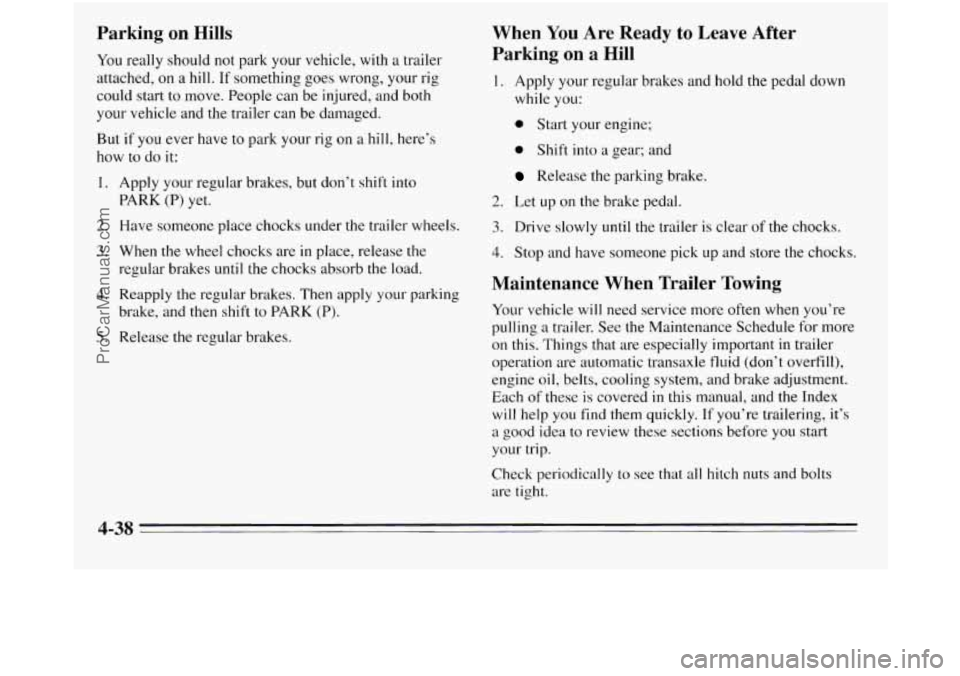
could start to move. People can be injured, and both
your vehicle and the trailer can be damaged.
But
if you ever have to park your rig on a hill, here’s
how to
do it:
1. Apply your regular brakes, but don’t shift into
PARK
(P) yet.
2. Have someone place chocks under the trailer whe
3. When the wheel chocks are in place, release the
regular brakes until the chocks absorb the load. els.
Parking on Hills
You really should
not park your vehicle, with a trailer
attached, on
a hill. If something goes wrong, your rig
4. Reapply the regular brakes. Then apply your parking
brake, and then shift to PARK
(P).
5. Release the regular brakes.
When You Are Ready to Leave After
Parking
on a Hill
1. Apply your regular brakes and hold the pedal down
while you:
0 Start your engine;
0 Shift into a gear; and
Release the parking brake.
2. Let up on the brake pedal.
3. Drive slowly until the trailer is cl
ear of the chocks.
4. Stop and have someone pick up and store the chocks.
Maintenance When Trailer Towing
Your vehicle will need service more often when you’re
pulling
a trailer. See the Maintenance Schedule for more
on this. Things that are especially important in trailer
operation are automatic transaxle fluid (don’t overfill),
engine
oil, belts, cooling system, and brake adjustment.
Each
of these is covered in this manual, and the Index
will help you find them quickly. If you’re trailering, it’s
a good idea to review these sections before you start
your trip.
Check periodically to see that
all hitch nuts and bolts
are tight.
4-3s
ProCarManuals.com
Page 262 of 390
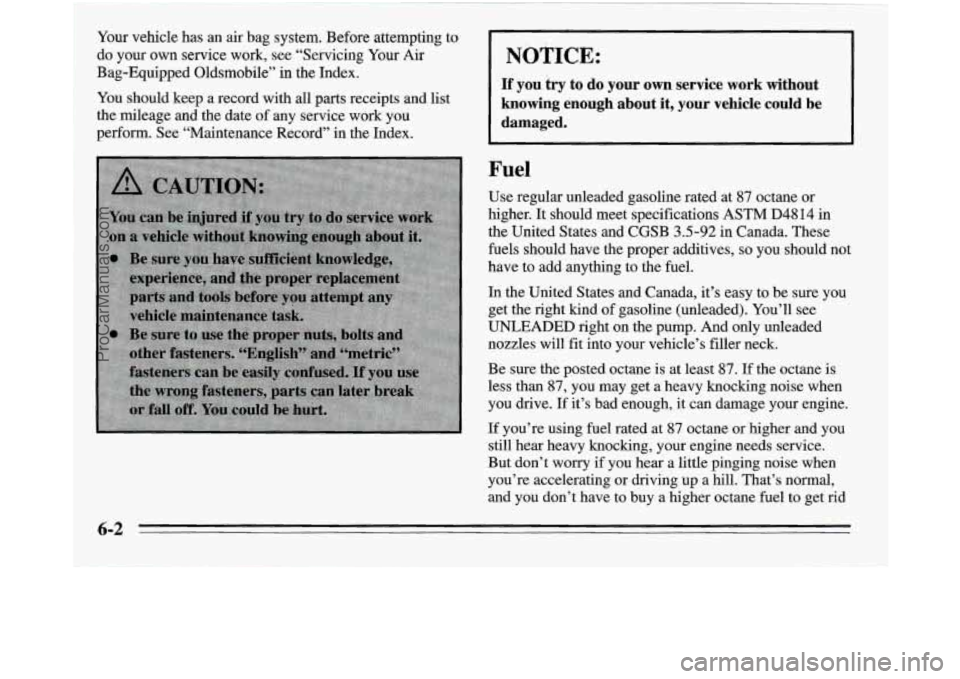
Your vehicle has an air bag system. Before attempting to
do your own service work, see “Servicing Your Air
Bag-Equipped Oldsmobile”
in the Index.
You should keep a record with all parts receipts and list
the mileage and the date of any service work you
perform. See “Maintenance Record” in the Index.
~~ ~~~~~ ~~ ~
NOTICE:
If you try to do your own service work without
knowing enough about it,
your vehicle could be
I damaged. I
Fuel
Use regular unleaded gasoline rated at 87 octane or
higher. It should meet specifications ASTM D4814 in
the United States and CGSB
3.5-92 in Canada. These
fuels should have the proper additives, so you should not
have to add anything to the fuel.
In the United States and Canada, it’s easy to be sure you
get the right kind of gasoline (unleaded). You’ll see
UNLEADED right on the pump. And only unleaded
nozzles will fit into your vehicle’s filler neck.
Be sure the posted octane is at least
87, If the octane is
less than
87, you may get a heavy knocking noise when
you drive. If it’s bad enough, it can damage your engine.
If you’re using fuel rated at
87 octane or higher and you
still hear heavy knocking, your engine needs service.
But don’t worry if you hear a little pinging noise when
you’re accelerating or driving up a hill. That’s normal,
and you don’t have to buy a higher octane fuel to get rid
6-2
ProCarManuals.com
Page 277 of 390
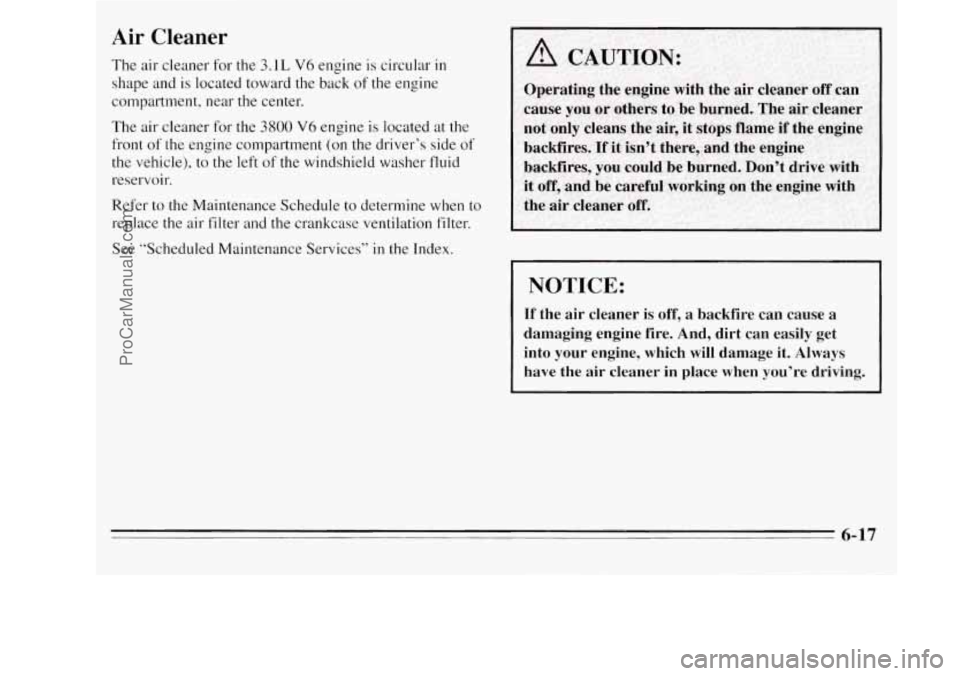
Air Cleaner
The air cleaner for the 3.1L V6 engine is circular in
shape and is located toward the back of the engine
compartment, near the center.
The air cleaner for the 3800 V6 engine is located at the
front
of the engine compartment (on the driver’s side of
the vehicle), to the left of the windshield washer fluid
reservoir.
Refer to the Maintenance Schedule
to determine when to
replace the air filter and the crankcase ventilation filter.
See “Scheduled Maintenance Services’’
in the Index.
I NOTICE:
If the air cleaner is off, a backfire can cause a
damaging engine fire. And, dirt can easily get into your engine, which
will damage it. Always
have the air cleaner in place when you’re driving.
ProCarManuals.com
Page 279 of 390
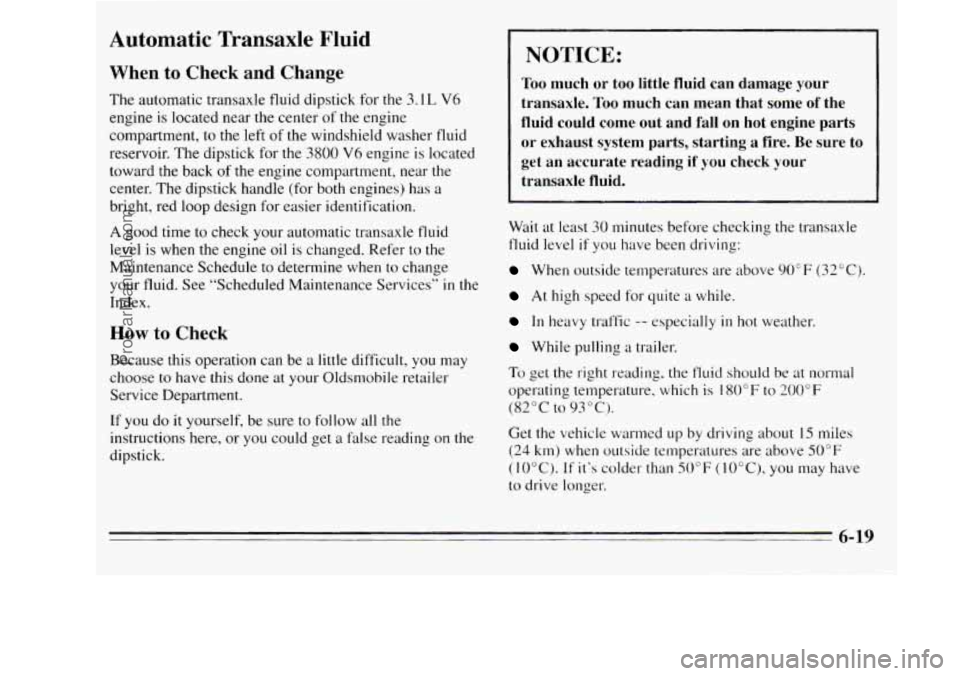
Automatic Transaxle Fluid
When to Check and Change
The automatic transaxle fluid dipstick for the 3.1 L V6
engine is located near the center of the engine
compartment, to the left
of the windshield washer fluid
reservoir. The dipstick for
the 3800 V6 engine is located
toward the back
of the engine Compartment, near the
center. The dipstick handle (for both engines) has
a
bright, red loop design for easier identification.
A good time to check your automatic transaxle fluid
level is when the engine oil is changed. Refer to the
Maintenance Schedule to determine when to change
your fluid. See “Scheduled Maintenance Services”
in the
Index.
How to Check
Because this operation can be a little difficult, you may
choose to have this done at your Oldsmobile retailer
Service Department.
If
you do it yourself, be sure to follow all the
instructions here, or
you could get a false reading on the
dipstick.
NOTICE:
Too much or too little fluid can damage your
transaxle.
Too much can mean that some of the
fluid could come out and fall on hot engine parts
or exhaust system parts, starting a fire. Be sure to
get
an accurate reading if you check your
transaxle fluid.
Wait at least 30 minutes before checking the transaxle
fluid level
if you have been driving:
When outside temperatures are above 90°F (32°C).
At high speed for quite a while.
In heavy traffic -- especially in hot weather.
While pulling a trailer.
To get the right reading, the fluid should be at normal
operating temperature, which is 180°F
to 200°F
(82°C to 93°C).
Get the vehicle warmed up by driving about 15 miles
(24 km) when outside temperatures are above 50°F
(10°C).
If it’s colder than 50°F (lO°C), you may have
to drive longer.
ProCarManuals.com
Page 281 of 390
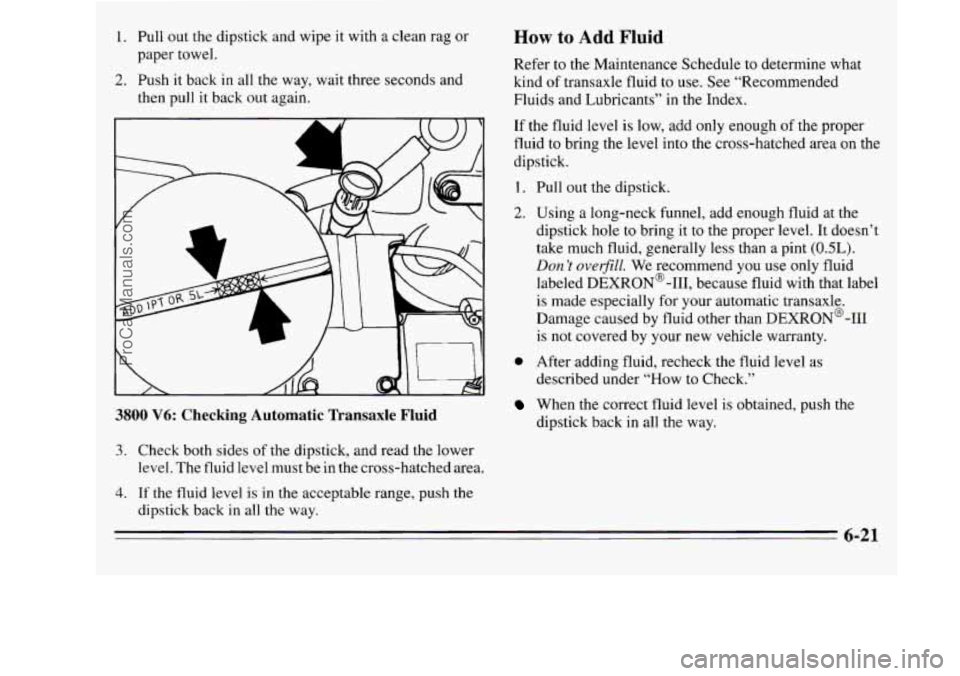
1. Pull out the dipstick and wipe it with a clean rag or
2. Push it back in all the way, wait three seconds and
paper towel.
then pull it back out again.
How to Add Fluid
Refer to the Maintenance Schedule to determine what
kind
of transaxle fluid to use. See “Recommended
Fluids and Lubricants”
in the Index.
r 1 L 7
3800 V6: Checking Automatic Transaxle Fluid
3. Check both sides of the dipstick, and read the lower
level.
The fluid level must be in the cross-hatched area.
4. If the fluid level is in the acceptable range, push the
dipstick back
in all the way.
If the fluid level is low, add only enough of the proper
fluid to bring the level into the cross-hatched area
on the
dipstick.
1. Pull out the dipstick.
2. Using a long-neck funnel, add enough fluid at the
dipstick hole to bring it to the proper level. It doesn’t
take much fluid, generally less than
a pint (OSL).
Don’t overfill. We recommend you use only fluid
labeled DEXRON@-111, because fluid with that label
is made especially for your automatic transaxle.
Damage caused by fluid other than DEXRON@-I11
is not covered by your new vehicle warranty.
0 After adding fluid, recheck the fluid level as
described under “How to Check.”
When the correct fluid level is obtained, push the
dipstick back in all the way.
6-21
ProCarManuals.com
Page 286 of 390
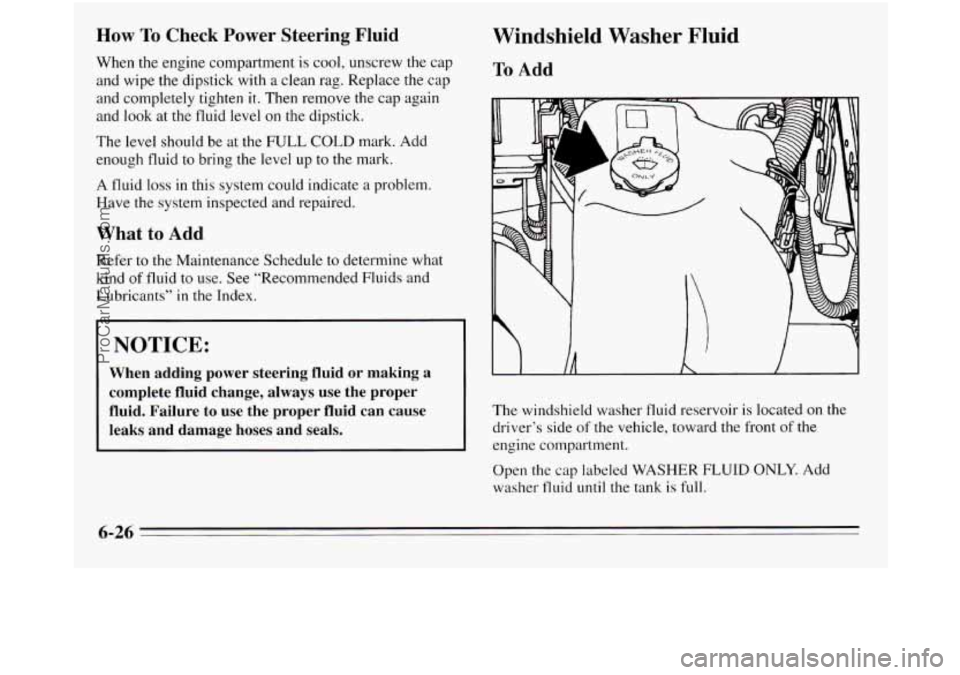
How To Check Power Steering Fluid
When the engine compartment is cool, unscrew the cap
and wipe the dipstick with
a clean rag. Replace the cap
and completely tighten
it. Then remove the cap again
and look at the fluid level
on the dipstick.
The level should be at the
FULL COLD mark. Add
enough fluid to bring the level up to the mark.
A fluid loss in this system could indicate a problem.
Have the system inspected and repaired.
What to Add
Refer to the Maintenance Schedule to determine what
kind
of fluid to use. See ‘‘Recommended Fluids and
Lubricants”
in the Index.
Windshield Washer Fluid
To Add
NOTICE:
When adding power steering fluid or making a
complete fluid change, always use the proper
fluid. Failure to use the proper fluid can cause
leaks and damage hoses and seals.
The windshield washer fluid reservoir is located on the
driver’s side of the vehicle, toward the front
of the
engine compartment.
Open the cap labeled
WASHER FLUID ONLY. Add
washer fluid
until the tank is full.
6-26
ProCarManuals.com
Page 296 of 390
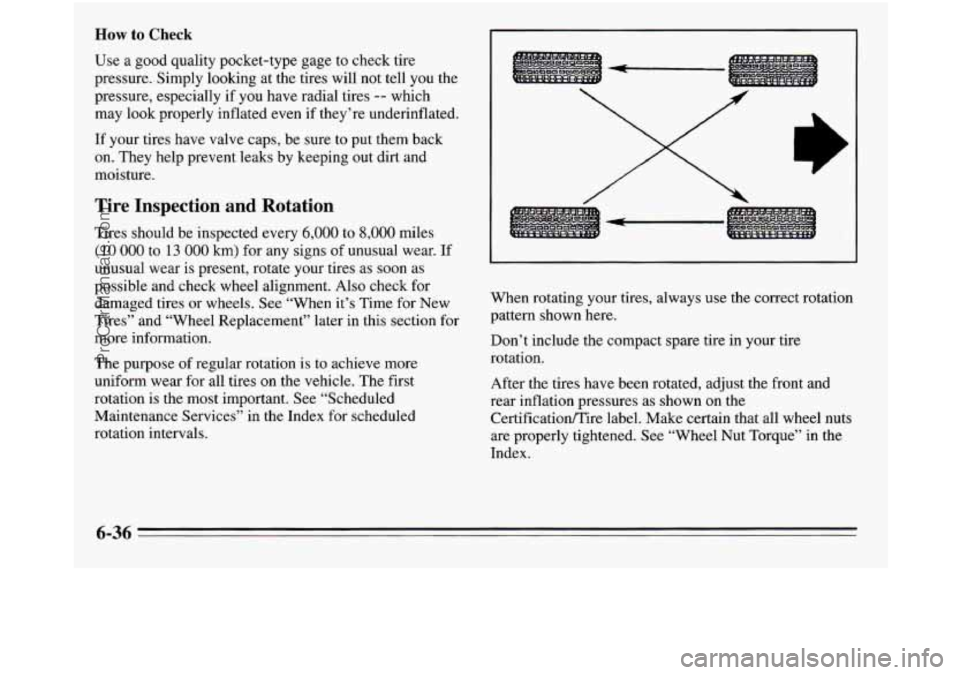
How to Check
Use a good quality pocket-type gage to check tire
pressure. Simply looking at the tires will not tell you the
pressure, especially if you have radial tires
-- which
may look properly inflated even if they’re underinflated.
If your tires have valve caps, be sure to put them back
on. They help prevent leaks by keeping out dirt and
moisture.
Tire Inspection and Rotation
Tires should be inspected every 6,000 to 8,000 miles
(1 0 000 to 13 000 km) for any signs of unusual wear. If
unusual wear is present, rotate your tires as soon as
possible and check wheel alignment. Also check for
damaged tires or wheels. See “When it’s Time for New
Tires” and “Wheel Replacement” later in this section for
more information.
The purpose
of regular rotation is to achieve more
uniform wear for all tires on the vehicle. The first
rotation is the most important. See “Scheduled
Maintenance Services” in the Index for scheduled
rotation intervals. When
rotating your tires, always use the correct rotation
pattern shown here.
Don’t include the compact spare tire in your tire
rotation.
After the tires have been rotated, adjust the front and
rear inflation pressures as shown on
the
Certificatioflire label. Make certain that all wheel nuts
are properly tightened. See “Wheel Nut Torque” in the
Index.
6-36
ProCarManuals.com
Page 308 of 390
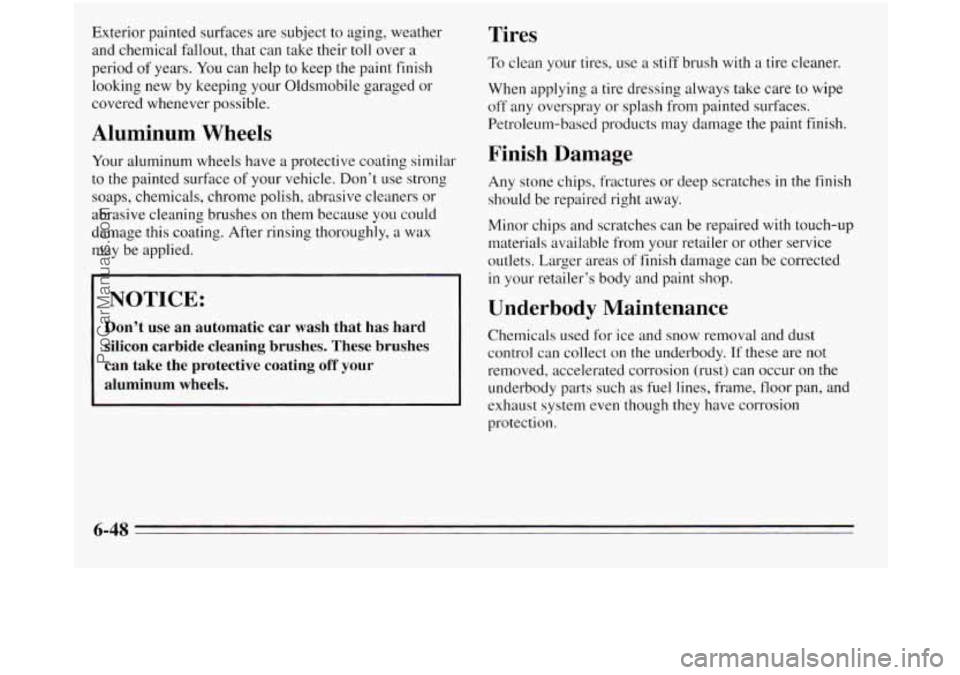
Exterior painted surfaces are subject to aging, weather
and chemical fallout, that can take their toll over
a
period of years. You can help to keep the paint finish
looking new by keeping your Oldsmobile garaged or
covered whenever possible.
Aluminum Wheels
Tires
To clean your tires, use a stiff brush with a tire cleaner.
When applying
a tire dressing always take care to wipe
off any overspray or splash from painted surfaces.
Petroleum-based products may damage the paint finish.
Your aluminum wheels have
a protective coating similar Finish Damage
to the painted surface of your vehicle. Don’t use strong Any stone chips, fractures or deep scratches in the finish
soaps, chemicals, chrome polish, abrasive cleaners or should be repaired right away.
abrasive cleaning brushes on them because yo~l could
damage this coating. After rinsing thoroughly,
a wax
may be applied. Minor
chips and scratches can be repaired with touch-up
materials available from your retailer or other service
outlets. Larger areas of finish damage can be corrected
in your retailer’s body and paint shop.
NOTICE: Underbody Maintenance
Don’t use an automatic car wash that has hard
silicon carbide cleaning brushes. These brushes
can take the protective coating
off your
underbody parts such as fuel lines, frame, floor pan, and aluminum wheels.
removed, accelerated corrosion (rust) can occur on the
Chemicals used
for ice and snow removal and dust
control can collect on the underbody. If these are not
exhaust system even though they have corrosion
protection.
6-48
ProCarManuals.com